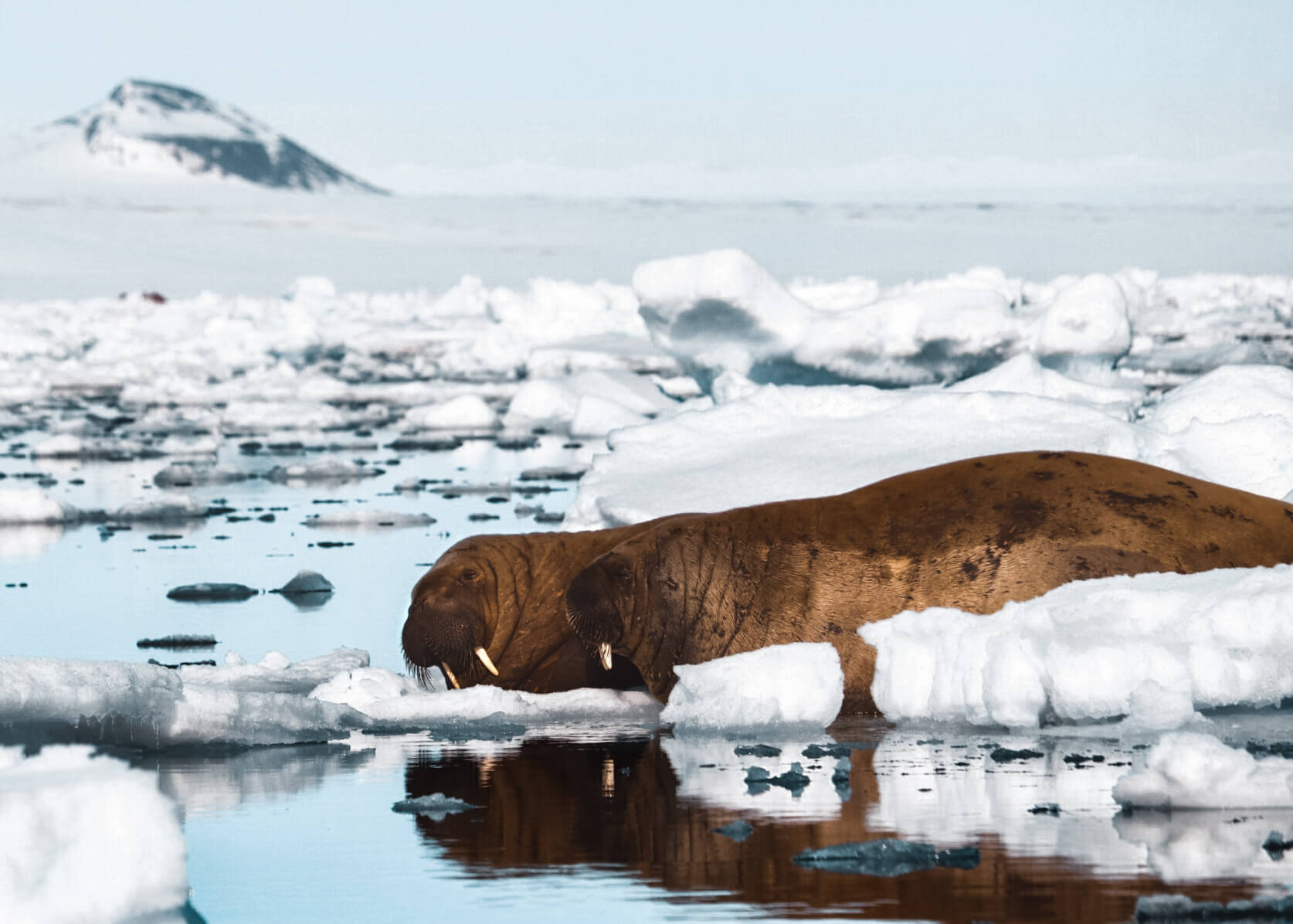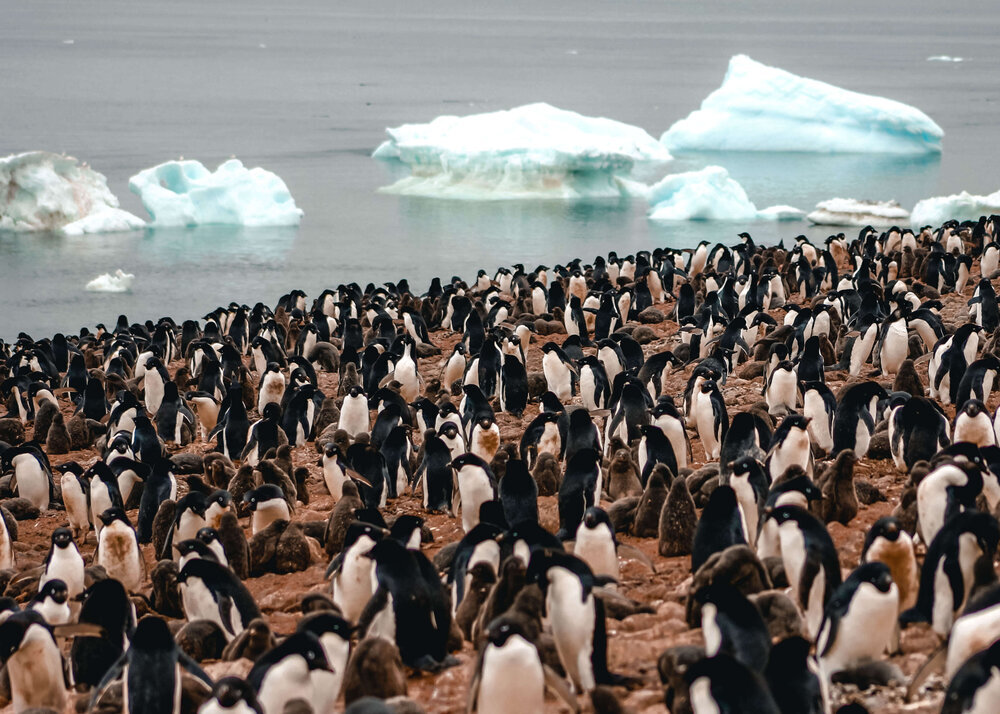Wildlife of Svalbard
The Svalbard archipelago sits quietly in the High Arctic, tucked between Norway and the North Pole. On an expedition around Spitsbergen, the westernmost island of Svalbard, I sailed among glaciers to spot the unique Arctic wildlife that abounds.
High up on the 78th parallel, far from the tendrils of modern society, the arctic tundra of Svalbard is found. It is known for its chilly climate, rugged terrain and - thankfully - for remaining mostly untouched. In a land where the polar bears outnumber the people, its lack of popularity is perhaps unsurprising. It wasn’t always that way though; in the 17th and 18th century it served as a profitable whaling base. After nearly decimating the whale population, the influx of greedy oil-seekers sailed away and in came the coal miners. Today, tourism and research are the dominating industries, with visitors coming from all over the world to see the icy landscape and snowcapped mountain peaks, as well as the wildlife that calls it home.
Whether you are headed there yourself and interested in what wildlife you can expect to see, or if you are merely curious and want to learn, this guide has you covered. All photos, unless otherwise noted, were taken on my expedition to Svalbard in June 2018, which you can read about briefly about in in more depth in Field Report: Svalbard.
Walrus
Let’s start with one of my favorite animals of the Arctic: odobenus rosmarus, which aptly translates to “tooth-walking sea horse.” These 2,000 pound behemoths are socially inclined and live to the ripe age of 30 years old.
Their quintessential tusks are multifunctional and bestowed upon both males and females, though male tusks can reach an impressive length of three feet. Not only do they help the hefty walrus haul out and make holes in the ice, but they are also used to fight and can dictate one’s place in the social hierarchy; the bigger the tusks the cooler you are in the walrus world. Males with larger tusks are particularly dominant and are known to have a harem of lady walruses.
Like myself, walruses have embarrassingly terrible eyesight. Unlike me, they have a mustache of fancy whiskers to help them out. (Thank goodness for glasses and contacts, a whiskered mustache would not suit me.) But theirs are no ordinary whiskers - they are actual organs with blood and nerves that allow them to differentiate between shapes and textures, which is particularly helpful when searching for mollusks, their snack of choice.
Interested in seeing something real cute? I recommend looking up a walrus baby. Though maybe I’m the only one who thinks a pudgy Benjamin Button-like creature with bulging eyes is cute.
Polar Bears
Easily the start of the Arctic show, polar bears are why most visitors make the arduous journey. They sit at the tippy-top of the Arctic food chain, a humbling reminder that the Arctic is their land. In fact, in the minuscule town of Longyearbyen, the jumping off point for expeditions and the largest of Svalbard’s three populated areas, no one can leave the city limits without a rifle since bears roam as they please.
During an expedition, you never step foot on land with a polar bear. If they are spotted after landing, it’s time to hightail it outta there. This is for everyone’s safety; you don’t want to become an appetizer (or dessert depending on your sweetness of character) and guides don’t want to save you at the cost of harming a bear. For this reason, bear sightings are from zodiacs and the ship. If you are truly lucky, however, one will come near on an ice floe and put his paws right up to the ship!
Over the years, polar bears have become the unofficial mascot of climate change, and rightfully so. Global warming has severely effected their numbers and consistently alter their behaviors and survival habits. You see, they rely on pack ice to hunt, but with an ever-warming planet, pack ice is melting at startling speeds. To find food, bears wander into areas populated by humans, putting both people and bears at risk. And yes, they kill people. And people heartbreakingly kill them in dire circumstances as well.
But that’s enough macabre talk, let’s chat about the impressiveness of the polar bear.
They may look cuddly, but polar bears are massive and powerful animals built with an anatomy to survive the harsh Arctic elements. To keep warm, they have black skin covered in a 4-inch layer of blubbery fat. Their thick claws help with walking on ice, while their ginormous paws double as paddles when swimming and hunting for prey. Speaking of prey, they aren’t picky, though they have a fondness for a good buffet of seals. It’s no surprise that they are top predators; adult males can stand ten feet tall and weigh an average of 1,000 pounds, while females clock in at about half of that. To hear what a polar bear sounds like and learn more about its habits, check out Polar Bears International.
Whales
When talking about whales, I tend to get very excited - both out of happiness and anger. Happiness because they are such fascinating, prehistoric, intelligent, badass animals that are impressive beyond belief. Anger and sadness because they are vastly misunderstood and mistreated, having to doggedly persevere in a world that they’ve lived in longer than any other creature.
In Svalbard, there are a variety of whales and seeing them in the wild is a consistently spectacular experience. Below are the main ones to be seen.
Beluga
Also known as the white whale, the beluga is among the smallest of whales (“small” meaning around 2,000 pounds). They are very social and travel in gender-separated pods near coastal shores. You can tell a calf from an adult as they are born gray and gain their white coloring after 7-12 years. There is a good chance to see them on an expedition but since they are shier than other whales it’s still quite a special experience.
Blue
Though little is known of their migratory route, the largest animal on the planet (upwards of 300,000 pounds) has been spotted in Svalbard’s waters a number of times. Blue whales tend to prefer solitude, though some choose to swim the great wide world with a partner.
Bowhead
Driven close to extinction during the height of whaling, the bowhead population is quite small and few people ever lay eyes on them. They are dark-colored and easily identified by their namesake curved (bow) mouth as well as by their white chin, which can break through ice. These glorious creatures are unique, even among whales, for many reasons: they stay in the Arctic year-round, females are larger than males, they have no dorsal fin, blow in a “v” shape, and can live for over 200 years. They are also a casual 200,000 pounds yet can still manage a graceful leap out of water.
Fin
Large, slender and lean (for a whale), these guys are speedsters (again, for a whale). They are found in all the world’s oceans though they migrate to Svalbard for a summer-long snack session.
Humpback
Ah yes, the beloved humpback whale. There is a good chance of seeing these guys as they like to be seen. They are especially fond of fancy acrobatic water leaps and can be easily distinguished by their bumpy exterior.
Minke
These small whales, whose name rhymes with pinky, look a bit like beefier dolphins if you ask me. Apparently that’s all I have to say about minkes.
Birds
Svalbard is an ideal place for bird enthusiasts to find themselves as over 200 bird species have been spotted to date. At least 30 are region regulars, following the sunshine north during summertime to get their food fix and hatch eggs in a safe environment. On a polar expedition, visitors are often surrounded by birds - sometimes literally by a million of them, as I was one chilly and rather noisy morning. Below are a few notable fellows.
A resting guillemot
A sky full of guillemots
A kittiwake on ice
Arctic tern
Perhaps most impressive of them all is the tern, who splits its time between Antarctica and Svalbard, thus taking the cake for the longest migration route on the planet. Quite the feat for a three ounce bird.
Northern fulmar
If you suddenly see a bird flying alongside the ship making weird, awkward eye-contact with you, chances are it’s a fulmar.
Kittiwakes
These are more dignified seagulls, though with with a less-than-dignified screech.
Atlantic Puffin
Who doesn’t love a puffin? The name alone is fun to say. With their pitiful eyes and bright orange beaks, they are easy to identify and among the few birds I would dare to call “cute.”
Ivory gull
Small angelic, all-white birds who are dainty as can be.
Common guillemot
Favoring rocky coastal cliffs, there is a very good chance of seeing the guillemot in action, and by that I mean laying eyes (and getting whiffs) of a massive colony of what feels like a bajillion of them. It also feels like a bajillion opportunities to be pooped on.
Other Animals
Arctic fox
In summer, these small and elusive critters have white fur to camouflage with the snow. Come winter, it turns brown to blend in with the polar night.
Seals
Aptly named species include ringed, bearded, and hooded seals. There are also harbour and harp seals floating around. Pups are awfully cute, too.
Lemming
A tiny, puffy rodent that compels an “aww” out of anyone who sees them.
Reindeer
Svalbard reindeer, or “caribou” depending on who you’re talking to, are smaller than others found around the world. They are avid travelers and found in low-snow areas with vegetation. They’re plentiful and easy to locate.

















